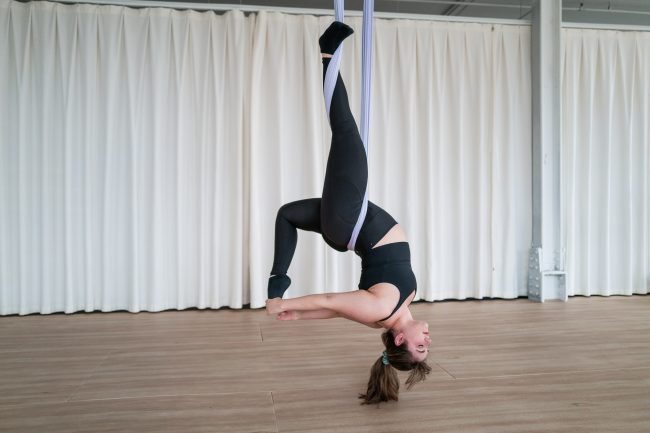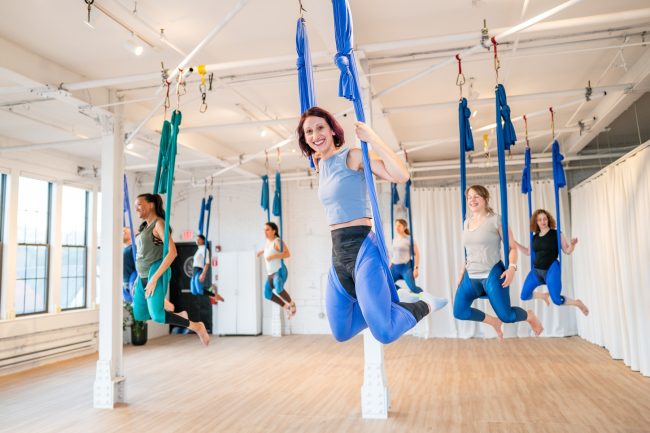Last month, I spent a weekend introducing students to aerial yoga at the Berkshire Yoga Festival, and during my breaks, I hopped into a few classes that couldn’t have been more different from one another. In one, I had my arms pinned behind my back, elbows flapping like chicken wings as my spine rolled and I breathed fast and loud through my nose. In another—thanks for the buckets of sweat, Jai Sugrim—I powered through rounds of yogi squats and squat jumps that felt more like bootcamp than bliss. And in yet another—looking at you, David Vendetti—I knelt twisted up, one hand reaching for the opposite heel, holding perfectly still in silence.
From the outside, these classes seemed like they came from entirely different worlds. Were they really all yoga? Even an alien might take one look and say, “Nope, not the same thing.” And honestly? They’d have a point.
As an aerial yoga studio owner, I get asked all the time whether my practice is considered “real yoga” (I even wrote a whole post about it here: Is Aerial Yoga Real Yoga?), and I realized this was the perfect chance to explore what yoga really is and how it shows up on a mat, on a cushion, or in a silk.
So… what makes something yoga?
Is it the movement? The stillness? The chanting? The spandex? The silence?
And if yoga can look so wildly different from class to class, where does aerial yoga fit in?
Yoga Isn’t a Pose, It’s a Practice
For all their differences, every one of those festival classes shared one thing: an invitation to turn inward. Whether I was bouncing, flapping, or holding still, I was encouraged to notice my breath, feel my body, and stay present with what was happening. That’s what transforms movement into yoga—not how it looks, but how it’s approached.
The same is true in aerial yoga. Yes, the movements can be playful, even acrobatic. But when we draw our attention inward, when we move with awareness rather than just momentum, it becomes a practice, not just an activity. The hammock becomes a tool for mindfulness, for exploration, for presence. In fact, many students are amazed to discover that aerial yoga offers the same grounding (and even more benefits) as traditional yoga, only from a different perspective.
The Mind-Body Connection (In Any Shape)
At its core, yoga is about connecting body and mind. It’s why we breathe with intention, why we move slowly and notice sensations. It’s about creating space—physically and mentally—to observe, process, and soften.
In aerial yoga, that connection is often amplified. When you’re wrapped in fabric or floating just off the ground, your awareness sharpens. You notice where you’re holding tension. You listen more closely to your breath. You feel when your body lets go. The hammock supports that connection by literally giving you space to feel differently.

Awareness sharpens when you’re floating.
Movement + Breath + Intention = Yoga
Yoga isn’t just a workout. It’s breath plus movement, guided by intention. Whether you’re flowing through sun salutations or resting in a supported backbend, you’re practicing presence. You’re anchoring your attention in the now.
Aerial yoga does this beautifully. Every transition, every wrap, twist, or flip requires focus. You can’t phone it in. Inversions especially demand a calm, steady breath and a willingness to trust. The body moves, the breath guides, and the intention anchors it all.
So… Is Aerial Yoga Real Yoga?
If yoga is about connecting breath, body, and mind; if it’s about presence, self-awareness, and moving with purpose, then yes. Aerial yoga is absolutely yoga. It might look a little upside down, but it’s built on the same foundations.
And if you’ve ever been in a silk, suspended in midair, fully aware of your breath and body in space, then you already know: this is yoga. Just with a little more hang time.
So the next time you see someone hanging out in a silk and you find yourself wondering if it’s “real yoga,” try asking: Are they breathing, feeling, and fully present?
If they are… that’s yoga.
And maybe it’s time to find out what it feels like for you. You might surprise yourself.

Curious? Your silk is waiting.
Author’s Note: A few parts of this blog were co-written with AI (because even writers need a sidekick sometimes).
